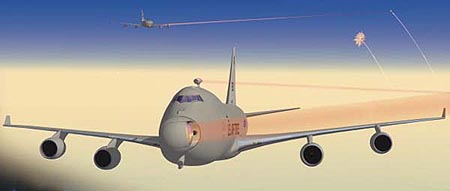
20 ÑÅÍÒßÁÐß 2000 ÃÎÄÀ
| ÃËÀÂÍÀß | ||
| ÍÎÂÎÑÒÈ | ||
|
Ñ÷åò÷èêè
|
||
|
|
||
|
AIRBORNE LASER 747-400 FREIGHTER MODIFICATIONS PASS HALFWAY POINT The biggest military modification programme ever at Boeing facilities in Wichita, Kan., has passed its halfway mark and progress continues on schedule.
Team ABL, Boeing, Lockheed Martin, TRW and the US Air Force, is building a revolutionary weapon system that will shoot down Scud-type ballistic missiles from a modified 747-400 Freighter aircraft. The Airborne Laser (ABL) will be able to locate and track missiles in the boost phase of their flight, then accurately point and fire the laser with such energy that the missiles will be destroyed near their launch areas. The aircraft will become the first ABL flying platform upon completion of the two-year modification effort in 2002 in Wichita. It then will undergo a complete systems functional check and flight-test schedule to verify aerodynamic stability and control. Artists Impression of Airborne Laser Brad Gorsuch, ABL programme manager, Wichita Maintenance and Modification Centre, said engineering on the project is now 75-percent complete after two years of work. Modification of the aircraft in Wichita began in January. "You can see the nose modification where we will install the turret in about a year and a half. It is being made by Lockheed Martin and will weigh about 14,000 pounds." On the main deck of the airplane in the "46 section," work continues on replacing and beefing up the floor beams. In the lower lobe area below where the laser modules will sit, the frames are being replaced where the titanium belly skins will attach. The belly skins, 25 feet long and 12 feet wide, are a major part of the plane. Other work currently being accomplished includes wiring and work on building a pressure wall to protect the flight crew from the laser modules and chemical storage. Gorsuch said the ABL programme is complicated and technical hurdles are on the horizon, but he is confident they will be solved. "For the magnitude of the modification involved, we are doing an outstanding job. We have some schedule issues because of the magnitude of the work, but we'll work through those and we're going to deliver this airplane on time in January 2002." After tests in Wichita, the aircraft will be flown to Edwards Air Force Base, Calif., for final systems integration and test. Then, the project will culminate with a missile shoot-down in 2003. The Air Force envisions a fleet of seven ABL aircraft, rapidly deployable anywhere around the world. © «Defence Systems Daily», 20.09.2000 |
||
|
|
| Ââåðõ |
Ñòðàíèöà îáíîâëåíà 21.09.2000
|
